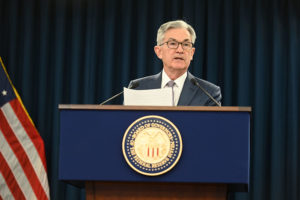
Former member of the Federal Reserve Board, Kevin Warsh, suggests that the Fed’s easy-money policies are putting the very social contract that governs America at risk. He writes in a Wall Street Journal op-ed:
If price stability is squandered, financial stability is put at risk. If financial stability is lost, the economy is imperiled and the social contract is threatened.
During the past several quarters, U.S. inflation has surged—now running about triple the Federal Reserve’s 2% target. The surge in prices is unlikely to reverse on its own. The longer that prices are unstable, the greater the challenge to the conduct of macroeconomic policy. The last thing the country needs is its third major economic upheaval in a decade and a half.
The consequences of inflation—and the attendant risks—have long been understood. In 1898 economist Knut Wicksell explained: “Changes in the general level of prices have always excited great interest. Obscure in origin, they exert a profound and far-reaching influence on the whole economic and social life of a country.”
Inflation is the sincerest form of fakery: A surge in the cost of living that robs hardworking Americans of the fruits of their wage gains. An incomparable asset boom predicated on perpetually low interest rates. Alchemy for an overly indebted nation. Vulnerability that can lead to miscalculation by a fierce geopolitical rival. And despair by the body politic, whose common sense is at odds with the anxious conformity of those in power.
Inflation is a choice. It’s a choice for which the Fed is chiefly responsible. The risk of an inflationary spiral arises when policy makers first dismiss the problem and then cast blame elsewhere. Inflation becomes embedded in the price-formation process when the central bank acts belatedly or with insufficient conviction. To date, the Fed has acted as an enabler.
The sure sign of a problem: when a president gives voice to the scourge of inflation—and takes executive action—well before the central bank acknowledges the severity of the situation.
“Supply-chain bottlenecks” is the popularized rationalization for the surge in prices. But the supply-chain story sheds more shade than light. Consumer prices are higher because prices are rising at the points of production, assembly and transportation. This is a description of the state of affairs, not its source. The Fed’s inertia in withdrawing extraordinary monetary policy—amid full employment—is the proximate cause of surging prices.
When monetary policy is too tight, it slows aggregate demand. When monetary policy is too loose, it damages aggregate supply. Extraordinarily aggressive monetary policy, namely quantitative easing, discourages investments in real assets like capital equipment relative to financial assets such as stocks. That’s why nonresidential capital investment in the real economy—things like port modernization—is running 7% below the pre-pandemic trend and 25% below trend since the advent of QE. A more exuberant stock market and a less resilient real economy are both consequences of the Fed’s extant policy regime.
By August 2020, the Fed had become impatient with the purported low inflation rate of the Ben Bernanke and Janet Yellen years. Chairman Jerome Powell called low inflation—which averaged 1.7% in the prior decade, a mere 0.3 point below the Fed’s target—the pre-eminent economic challenge of our time. So the Fed bet on a new policy regime to get inflation higher. It worked. It’s not the first time a central bank wanted a little more inflation and got a lot more.
Last year, in another break with precedent, the Fed loudly and explicitly endorsed a blowout in federal spending. Congress swiftly agreed. Federal spending increased from an average of about 21% of gross domestic product in the prior decade to more than 30% in fiscal 2020 and 2021. National debt relative to GDP increased from 79% in 2019 to more than 100% today. Most troubling, the Fed bankrolled the fiscal profligacy, purchasing more than half of the new Treasury debt issued this year. Call it monetary dominance.
In congressional testimony recently, Mr. Powell made clear he was surprised and troubled by the medium-term trajectory of inflation. At this week’s Federal Open Market Committee meeting, the Fed seems ready to abandon its policy priors.
Achieving a soft economic landing at this late stage is difficult. If the sole task were to drive inflation down, the Fed would immediately taper its asset purchases and start raising rates. But a significant tightening cycle would likely cause market volatility to surge and assets to reprice. The authorities have expressed little concern about financial excesses, bubbles or financial imbalances. Hope they’re right. I expect tension between the Fed’s goals of price stability and financial stability to be in sharper relief in the new year.
Read more here.



